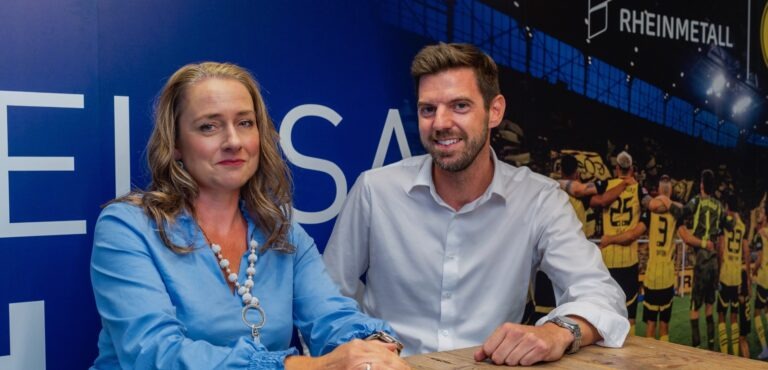
Strengthening Health Together
7. October 2025

18. August 2025
How can artificial intelligence (AI) take advantage of its strengths on the battlefield of tomorrow? Where are the risks? Klaus Kappen, Chief Technology Officer at Rheinmetall, coordinates research and development. He provides the answers in an interview with DIMENSIONS.

Klaus Kappen,
born in 1969, has been the Chief Technology Officer (CTO) of Rheinmetall AG since 2018. In this role, he is responsible for creating and maintaining Rheinmetall’s technological expertise as well as coordinating all research and development projects. With his many years of expertise in military research and technology, Kappen supports other departments in developing comprehensive system concepts for large-scale projects for the armed forces.
How do you assess the current development of artificial intelligence and its impact on industry?
We are in the midst of a new industrial revolution that will affect many areas of life – and it is already doing so today. It is driven primarily by the availability of increasingly powerful hardware that enables enormous computing power. AI will have an impact on processes throughout industry and will change the development of technologies significantly. Rheinmetall wants to play an important and formative role here by using AI to further enhance our products. However, the premise will always be to maintain control. Another challenge is to verify seemingly plausible results produced by AI. Artificial intelligence is based on machine learning, which means that any AI can only be as good as its database, i.e. the learning data it is fed.
In which areas do you see the greatest potential?
AI is already an important tool for us at Rheinmetall. It is increasingly supporting us in internal business processes, in IT, in development, and in testing. AI opens up entirely new possibilities for simulation. Just one example: in the USA, nuclear tests are already being simulated on supercomputers through AI assistance.
In the future, AI will help people wherever decisions need to be made in a dynamic environment based on comprehensive data. This will become increasingly important, particularly in a military context, where highly complex situations and huge amounts of reconnaissance data must be dealt with – and every second counts when tactical decisions are needed.
What role does AI play at Rheinmetall, both in the civil and military contexts?
AI has long been part of our corporate strategy; we are becoming an AI house. Together with our innovation team at Rheinmetall IT Service, we have already identified around a hundred so-called use cases for AI in our investigations that involve supporting everyday work, and we are now validating them. These include chatbots, knowledge management, process automation, quality control, and assistance solutions for creating files for PowerPoint or other applications. It doesn’t matter to us whether these potential applications are military or civil in nature, because technically there is no difference. AI is finding its way into many of our products and will support and relieve soldiers in many of their tasks in the future.

How does AI influence decisionmaking processes in military operations? What are the advantages and the risks?
In future, AI will primarily play a role in tactical systems in all military areas: in the gathering and evaluation of information, in decision-making, and in the attainment of combat superiority. For example, AI can be trained to recognise and identify enemy vehicles and to propose courses of action. AI thus helps humans to improve the quality of information in dynamic situations and to make decisions.
Who is driving this development? Are customers demanding AI in their systems, or is the industry
pushing it forward?
I think it’s both. We show our customers what is technically possible and where technology can relieve people. On the other hand, the military has to cope with increasingly complex tasks with a decreasing number of personnel, because manpower is a scarce resource. That’s why our customer attaches great importance to automating repetitive tasks and using technology to relieve people of unnecessary tasks.
But aren’t technical systems also becoming increasingly complex, to the point where humans will no longer be able to operate them without AI support?
One could see it that way – some cars are already overwhelming their drivers today. In the military sector, the more tasks the operator has to perform, the more assistance is needed. AI will therefore become an indispensable component of state-of-the-art combat systems.
Let’s stay at combat systems. Will we have to fear killer robots in the future?
We won’t build them. We’re not allowed to build them – and our customers don’t want them either. After all, there are clear rules of engagement and other legal requirements that always place responsibility with humans. AI does not make independent decisions in our systems but rather makes suggestions based on the information it has evaluated. Humans are responsible for everything they do: when firing artillery, deploying a guided missile – or even a semi-automated weapon. This is referred to as the “human in the loop” principle: humans have ultimate control, make the decisions, and bear the responsibility.
But would a killer robot that makes its own decisions be technically possible?
Certainly. And unfortunately, we cannot assume that all countries or actors will adhere to the same ethical standards and international regulations that are binding for us. In the military sphere, we must expect that one day we will be facing killer robots.

Do you already have products that use AI?
We are already delivering products that are “ready for AI”, such as the Boxer wheeled armoured vehicle in the Heavy Infantry Weapon Carrier version for the Bundeswehr. If the customer wishes, we can retrofit the AI later. This specifically involves an AI-based turret architecture that we have developed – the Automated Turret Target Acquisition Component – also known as AT-TAC. It serves to automatize reconnaissance and observation tasks in the turret, hence assisting in target search, classification, and threat assessment. Our new Panther battle tank and Lynx infantry fighting vehicle are also prepared for the use of AT-TAC. When we deliver SAR reconnaissance data from space to our customers in the future …
… from your partnership with Finnish satellite operator ICEYE …
… yes, AI also plays an important role in evaluating and utilising this data. And in the drone sector, we are developing a neural network for our Unmanned Aerial Vehicles (UAVs) that can identify potential military targets from a drone’s perspective, even from a great distance. We are also working on an AI model that enables the recognition of an object from the perspective of another drone or at a later time. This is already being integrated into the first UAVs. In the audio event classification, we are focusing on passive audio reconnaissance to support situation awareness by using AI to warn us of approaching vehicles, drones, etc. – as an artificial intelligent ear. I could list many more examples …
…certainly, also from the civil sector?
Of course. We already use AI for bird protection in wind turbines, for example. Or in driver monitoring systems, which will be required by law in all new civilian vehicles in the future. AI can recognise faces, but also gestures, yawning, blinking, and much more. At our subsidiary Rheinmetall Yardstick Robotics, we are working on the AI-based commissioning and certification of robot systems, for example for learning new tasks such as loading and unloading for autonomous transport on a factory site.
How does Rheinmetall protect its AI systems from cyberattacks and manipulation?
On the one hand, AI systems are vulnerable to so-called adversarial attacks. If an adversary is familiar with the AI model, they may be able to mislead the AI by deliberately falsifying data in a way that is difficult or impossible for the user to detect. The reliability or resilience of AI is therefore a factor we consider to be highly important.
On the other hand, objects recognisable by AI systems – via satellite or other imaging sensors – can also be camouflaged by means of optical distortion so that they are no longer reliably identifiable by AI. On their own terrain, an enemy can easily employ camouflage and deception. However, data from the past can provide important reference points that could be used to verify and identify such distortions.
Consequently, the same applies here: control is better?
If I use several sensors independently of each other and combine the data obtained – this is referred to as multi-sensor data fusion – I can reduce risks. The more data I have for validation and comparison or for retraining models, the more reliably the AI works. And as with all military systems, the same applies here: it must not fall into enemy hands. In this case, protection and self-destruction mechanisms come into effect.
How does Rheinmetall manage to attract qualified specialists in the global competition for AI talent?
We are in a comfortable position here, as we receive many applications from people who would like to join us. We also cooperate with several universities and research institutions, and are in contact with young talent. “Techies” are keen to get involved with us.
In Germany, civilian and military research have so far been largely separated. Is the civil clause, which still exists at many universities, a hindrance?
At present, a lot is changing. We are receiving many enquiries from universities and research institutions that would like to work with us and carry out mutual projects. In Bavaria, the government has explicitly asked universities to conduct research for dual use or purely military projects. Many universities have already dropped their civil clauses or are at least discussing them.
Is Europe doing enough to keep up with the USA in this important future technology?
Whether it is enough remains to be seen – but a lot is already happening. The EU is investing heavily, for example through the Digital Europe programme, which is worth around eight billion Euros, as well as through the InvestAI initiative, which is set to trigger around EUR 200 billion in private investment in AI. Brussels is aiming to establish a Europe-wide network of so-called AI factories and wants to create AI gigafactories for around EUR 20 billion to increase computing power and support start-ups, research and industry. These facilities will provide access to high-performance computers and large amounts of data.
Let’s take a look at the future – what will happen next?
The growth in capability and combat effectiveness of our products will be driven by software and AI in the future. Our vehicles and system architectures will allow upgrading during the product’s life cycle with minimal effort. Many systems will be automated to the utmost level in the future. Humans will only intervene where artificial intelligence cannot provide a solution and/or where responsibility is required. All this is going to happen rather quickly – the future is already within reach!
Mr. Kappen, thank you very much for the interview.
The interview was conducted by Oliver Hoffmann.
Click here to receive push notifications. By giving your consent, you will receive constantly information about new articles on the Dimensions website. This notification service can be canceled at any time in the browser settings or settings of your mobile device. Your consent also expressly extends to the transfer of data to third countries. Further information can be found in our data protection information under section 5.